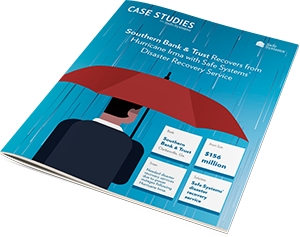The Dangers Financial Institutions Face with a DIY Approach to Disaster Recovery

Disaster recovery planning is an essential aspect of protecting a financial institution’s data, infrastructure, and overall business operations. It encompasses restoring access to the information technology systems and other resources that organizations need to resume critical business functions. This includes everything from networks, servers, and computers to software applications, data, and connectivity (fiber, cable, or wireless).
Without all the necessary system components in place, financial institutions will not be able to access critical files and applications and function effectively during a disaster situation. This can result in significant losses in employee productivity, business and, ultimately, public trust. Given all the looming threats—natural disasters, fires, floods, power outages, hardware failures, or plain human error—a do-it-yourself (DIY) approach to disaster recovery can be dangerous for banks and credit unions.
A DIY approach to disaster recovery is when a financial institution performs or puts together a disaster recovery solution in-house and all hardware and software that is required must be implemented by an IT staff member. While this can be costly depending on the amount of resources an organization needs to restore and maintain their environment, it is also a technical and time-consuming process, which can be a burden for institutions with limited IT staff.
So Much at Stake
Most DIY disaster recovery solutions involve multiple technologies along with automation, scripting, and well-documented procedures. These components and processes can be difficult for a static IT environment to manage, and technology continues to change and evolve, adding an extra layer of complication to the process. A DIY approach requires in-house resources to be available, and in the case of a disaster, communications may be limited, or the employees may be caught in the disaster themselves and unable to respond.
Testing is an important component of disaster recovery to ensure the institution can recover quickly and meet its unique Recovery Time Objectives (RTO) and Recovery Point Objectives (RPO). However, DIY disaster recovery solutions are often difficult to test because few IT departments are equipped to do a full outage simulation with complete failover to the disaster recovery environment. Testing enables failures to be documented and corrected, but without proper testing, the risk of extended downtime in the event of an actual disaster remains high.
The DIY disaster recovery approach often starts with the best intentions. However, a lack of understanding of the ongoing time commitment by senior management and the IT knowledge required to keep disaster recovery systems up-to-date and effective is easily overlooked as time passes. At the very least, inadequate disaster recovery can end up costing a financial institution more time and expense. As a worst-case scenario, it can lead to reputational damage if the institution cannot successfully bounce back from a disaster or other business disruption.
Benefits of a Managed Services Provider
To combat these issues, financial institutions should consider using a managed services provider to support their disaster recovery needs. This can offer a more affordable, feasible, and reliable alternative than going the DIY route. A managed site recovery solution that replicates servers from a financial institution’s site to the cloud can get the organization back up and running in minutes—not hours or days—after a natural disaster, system outage, or other disruption. Partnering with the right services provider will also ensure financial institutions find the right-sized solution for their needs so they are not underestimating or over-spending trying to do it themselves.
In addition, working with a managed services provider can provide several other benefits over a DIY solution. For one, the solution is setup, installed, monitored, and maintained by experts in the field. The institution doesn’t have to worry about their key IT personnel spending their time focused solely on the recovery process during a disaster. Instead, they can focus on getting users setup on computers, ensuring printers are connected, and verifying that critical applications are installed. In short, managing the disaster recovery process would just be another burden for them to bare. Community banks and credit unions have the comfort of knowing that a skilled managed services provider and redundant resources will be available when needed.
A managed services provider can also provide annual DR testing and on-going support to ensure the institution is well-equipped to recover from any disaster.
All financial institutions can benefit from managed site recovery services. And partnering with a managed services provider can be especially advantageous for banks and credit unions with branches that are grouped within the same geographic area. The impact of a storm could be even more devastating to these types of institutions if they lose their only branch or the location hosting communication to their core provider.
A DIY approach may seem like the easier route to take, but when a disaster strikes, financial institutions shouldn’t have to recover on their own. A managed services provider can work as an extension of the internal team to provide dedicated support and ensure the institution recovers quickly and efficiently. The goal of a disaster recovery program is to ensure continuity, not only for the financial institution, but for the communities it serves. In the event of a disaster, financial institutions need to have a solid DR environment in place and detailed processes to recover successfully. Working with a team that can effectively address the institution’s unique needs and provide dedicated DR support streamlines internal processes, improves disaster preparedness, and provides confidence that no matter what disasters arise, the institution will be able to resume business operations.



